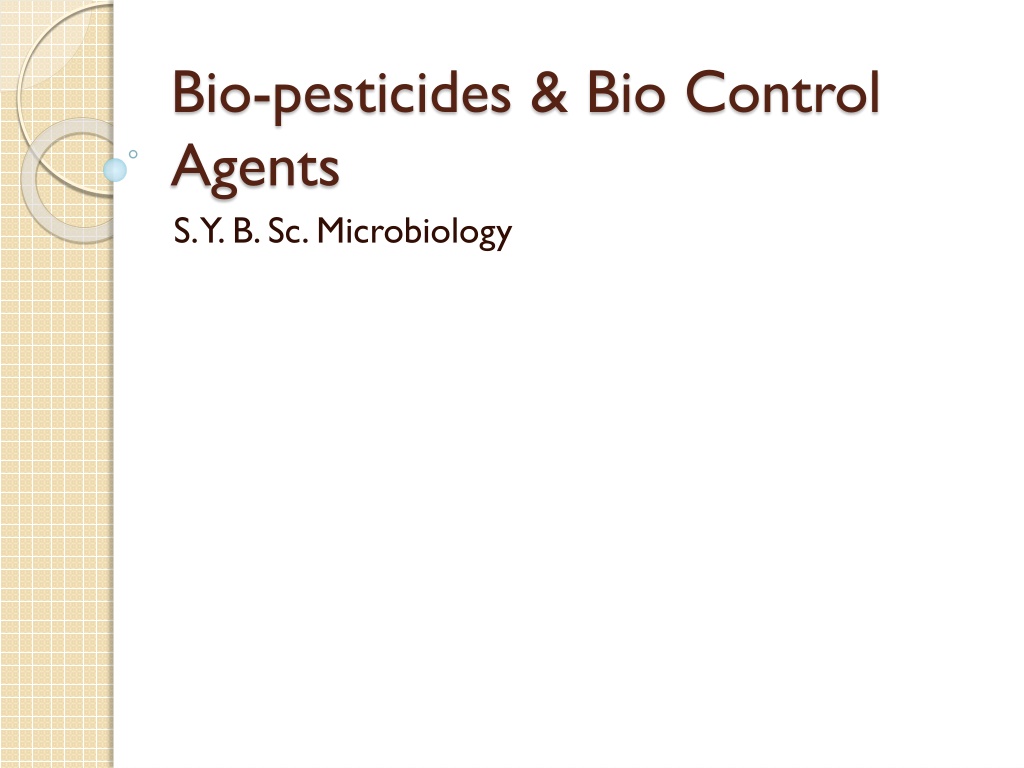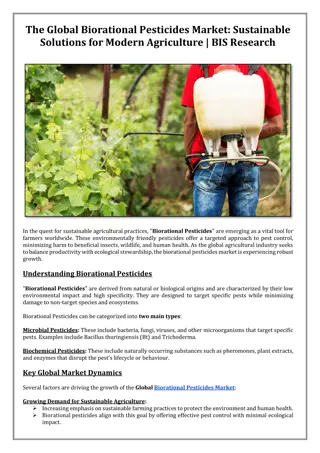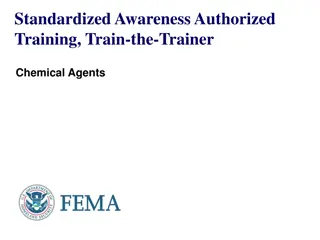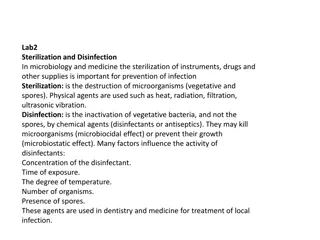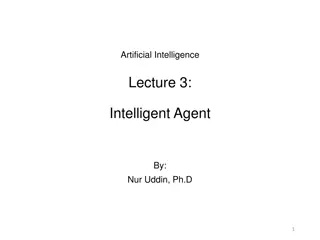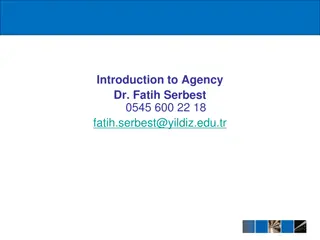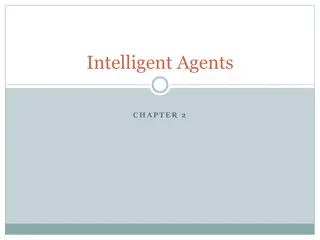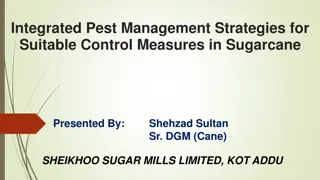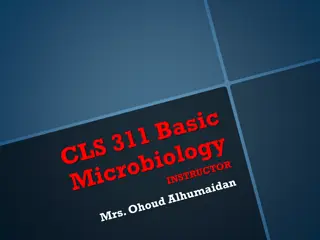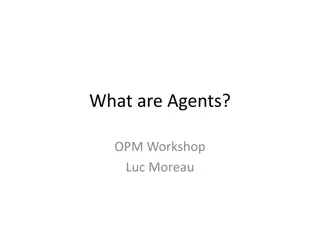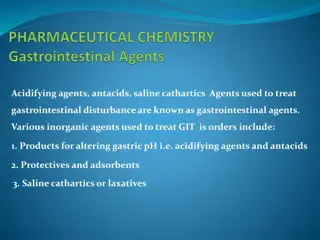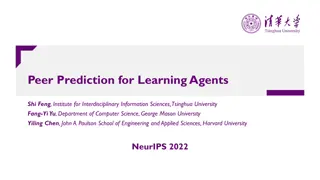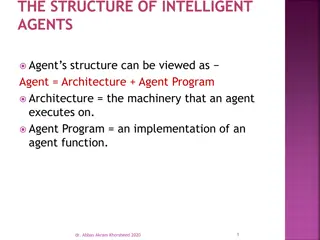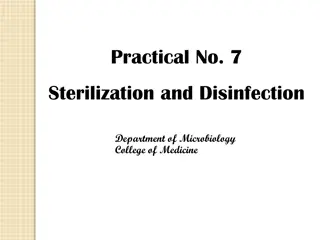Bio-Pesticides and Bio-Control Agents in Microbiology
Bacteria can infect various organisms, and some can be beneficial as bio-control agents against pests. Pseudomonas species and Bacillus thuringiensis are commonly used as bio-pesticides due to their abilities to inhibit pathogens and control insect populations effectively in agriculture.
Download Presentation

Please find below an Image/Link to download the presentation.
The content on the website is provided AS IS for your information and personal use only. It may not be sold, licensed, or shared on other websites without obtaining consent from the author.If you encounter any issues during the download, it is possible that the publisher has removed the file from their server.
You are allowed to download the files provided on this website for personal or commercial use, subject to the condition that they are used lawfully. All files are the property of their respective owners.
The content on the website is provided AS IS for your information and personal use only. It may not be sold, licensed, or shared on other websites without obtaining consent from the author.
E N D
Presentation Transcript
Bio-pesticides & Bio Control Agents S. Y. B. Sc. Microbiology
Bacteria can infect human beings, animals and plants They are pathogenic but sometimes this ability to infect is a boon There are some organisms that are pathogenic to insects, pests and kill a wide variety of insects and can be used as Bio Control Agents
Pseudomonas as insecticide Pseudomonas aeruginosa is among the most frequently described pathogen causing disease in insects Pseudomonas cepacia is the most versatile bacteria of soil A human pathogen a plant pathogen and also antagonist to plant pathogens through production of antibiotic Pyrrolinitrin. They inhibits root pathogenic fungi Rhizoctonia solani, Pythium spp on seed treatment.
It is a Gram negative bacteria also known to produce siderophores Also acts as plant growth promoting rhizobacteria (PGPR) They colonize roots to produce antibiotics against plant pathogens or siderophores They have adverse effects on the growth of pathogens. Siderophores chelate Fe++and make Fe+++unavailable for growth of other bacteria. They are iron chelating low molecular weight compounds
Pseudomonas fluorescence One of the most important BCA They are common PGPR and produce siderophores It produces fluorescent siderophores called Pyoverdine or Pseudobactrin Low mol. Wt. water soluble, high affinity Fe3+ chelators and inhibit pathogens by creating iron deficient conditions Inhibit Rhizoctonia solani, Pythium spps, Fusarium spps on cotton seed treatment
Bacillus thuringensis Widely known as Bt. Produces -exotoxin, -exotoxin -endotoxin (Parasporal body) Reported to kill insects like moths, beetle, flies, aphids, insects, ants, termites, midgets, butterflies and some pathogenic fungi. Some of the Bt. Strains are pathogenic to cockroaches, snails and protozoa. Produces exo and endo toxin hence has tremendous significance in agriculture
Used as insecticide against almost 100 Lepidoptera & Diaptera spps Bacillus thuringensis is a crystalliferous bacteria. They have a crystalline parasporal body that accompanies sporulation. On ingestion of Bt. The high pH and reducing agents in the gut of the insect dissolve the toxic crystalline protein.
The gut is damaged and becomes non functional The feeding ceases almost immediately The insect dies within 24 to 48 hrs. Protein does not dissolve in warm blooded animals hence non toxic to them After the harvest of Bt. at the end of fermentation the vegetative cells and spores are mixed with bentonite or other material as carrier. It is applied as water spray.
Submerged fermentation of Bt. Working culture slant Broth culture 500 ml 6 lit small fermentor 500 gallon that is 2000 lit. fermentor for inoculum preparation Production tank or bioreactor Medium of seed fermentor contains beet molasses1%, corn steep solids 0.85%, Calcium carbonate 0.1%
Production medium contains beet molasses 1.86%, corn steep solids 1.7% cotton seed flour 1.4% and calcium carbonate 0.1% A spore count of 2-5 109 spores/ml is attained within 28-32 hrs.
Viral Insecticides Viruses and their products are commercially exploited in place of chemical insecticide Viruses of the family Baculoviridae are pathogenic to arthropods. Viruses contain lipid envelope with circular double stranded DNA genome of 80-150 kb pairs They do not infect vertebrates, non arthropod species. Naked DNA of these viruses is infectious.
